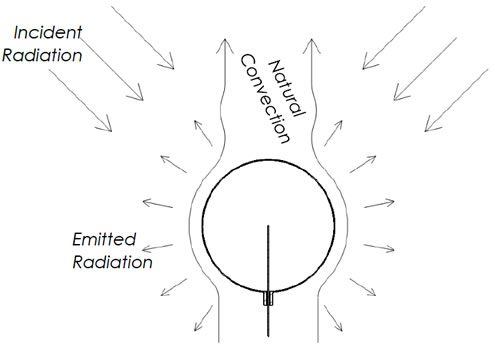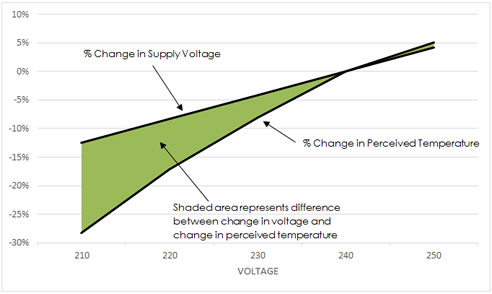Why Supply Voltage to Electric Radiant Heaters is Critical

By Tim Westendorp
Product Design Engineer at Thermofilm Australia
Executive Summary
This report provides a brief analysis of the relationship between supply voltage to an electric radiant heater and the level of comfort heating provided as measured by black globe temperatures. Results demonstrate that lower supply voltages result in disproportionally lowers the comfort levels.
Method of Analysis
A single HEATSTRIP® Classic THH2400A was mounted at a height of 2.4m. A black globe was placed 800mm below the heater surface. The heater was then operated and allowed to stabilise at various supply voltages.
Black globes provide a measure of perceived temperature by measuring the balance of incident radiation, emissive radiation and natural convection. The globe consists of a thermocouple inside a 150mm dull black painted copper sphere.
Radiant heat transfer is highly dependent on the heater surface temperature. The relationship between supply voltage and perceived temperature is non-linear:
Voltage > Power > Heater Temperature > Radiant Heat Transfer > Perceived Temperature

Results
The relationship between supply voltage and perceived comfort is shown in the chart below. Thermofilm's test results clearly demonstrate that a reduction in supply voltage produces a disproportionally larger reduction in perceived temperature. For example, an 8.3% reduction in supply voltage (220V) results in a perceived temperature reduction of 17%.

Recommendation
Thermofilm strongly recommends electric radiant heaters, especially HEATSTRIP® heaters, be operated at or very close to the intended design voltage of 240V to achieve optimal performance and customer satisfaction.

|






 Gas BBQ with Ceramic Infrared Burners by
Gas BBQ with Ceramic Infrared Burners by Electric Heater with WiFi by Thermofilm
Electric Heater with WiFi by Thermofilm Compact Electric Outdoor Kitchen by
Compact Electric Outdoor Kitchen by Infrared Commercial Heater for Coastal
Infrared Commercial Heater for Coastal Gas BBQ with Trolley by Thermofilm
Gas BBQ with Trolley by Thermofilm Outdoor Gas Heater by Thermofilm
Outdoor Gas Heater by Thermofilm 4 Benefits of Infrared Barbecues by
4 Benefits of Infrared Barbecues by Small Electric Infrared Heater by
Small Electric Infrared Heater by Electric BBQ with Trolley by Thermofilm
Electric BBQ with Trolley by Thermofilm Infrared Heater with Wheels by
Infrared Heater with Wheels by Crossray Mini Outdoor Kitchen by
Crossray Mini Outdoor Kitchen by Wall Mounted LPG Heater by Thermofilm
Wall Mounted LPG Heater by Thermofilm Advantages of Infrared BBQs by
Advantages of Infrared BBQs by Slimline Electric Heater by Thermofilm
Slimline Electric Heater by Thermofilm Portable LPG Heater by Thermofilm
Portable LPG Heater by Thermofilm CROSSRAY Portable Electric BBQ by
CROSSRAY Portable Electric BBQ by Remote Control Heater by Thermofilm
Remote Control Heater by Thermofilm Wall or Ceiling Mounted Electric
Wall or Ceiling Mounted Electric CROSSRAY Freestanding 4 Burner Gas BBQ
CROSSRAY Freestanding 4 Burner Gas BBQ Heatstrip Indoor Quiet Indoor Heater
Heatstrip Indoor Quiet Indoor Heater
